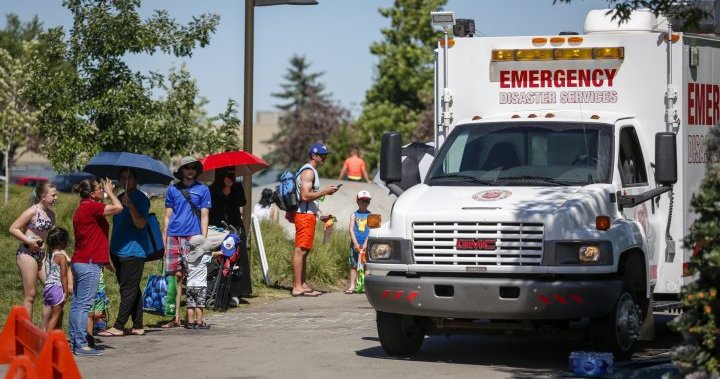As Western Canada reels from a blistering heat wave that has killed hundreds of people, sparked wildfires and several national heat records, experts are warning that the extreme weather is going to persist in other parts of the country well past Canada Day.
While the blistering hot temperatures continue to move east away from B.C., Global News meteorologist Ross Hull said that the sweat inducing weather is far from over.
According to Hull, many parts of Canada are still going to be hit by sweltering hot temperatures — even into the next week — even though the worst of the heat wave may have passed.
Read more:
Hundreds of people have died from extreme heat in western Canada, U.S., officials say
“The real extreme heat now, or at least where the heat dome is now, is heading is Alberta, Saskatchewan and Manitoba,” he said.
While many parts of Alberta are now getting bombarded with record breaking temperatures, Hull said that Saskatchewan and Manitoba should be bracing for peak temperatures in the high 30s within the next couple days.

“So still another hot weekend, likely records (being) broken in Alberta, Saskatchewan and Manitoba over the next couple days,” said Hull. “We’re in the midst of it, the centre of it has moved out of B.C.”
Six wildfires are now spreading across B.C., many having been started by the tinder-dry climate and lack of rain.
The small community of Lytton, B.C., which set several national heat records for the country over the weekend, is now being ravaged by a wildfire that has left at least two people dead and the majority of the town a smoldering ruin.
Read more:
B.C. wildfire map 2021: Location and size of the fires burning around the province
Authorities said Wednesday that they were also investigating hundreds of deaths in Canada and south of the border that were linked to extreme heat.
In B.C. alone, the coroner’s office said it had received reports of 486 “sudden and unexpected” deaths over the last week as temperature levels skyrocketed to record levels.
On Thursday, Alberta set at least 49 temperature records while officials in Jasper Park warned of potential fire danger.

Temperatures in Banff and Edmonton areas reached at least 37 C, while the Calgary area saw nearly 36 C. Fort McMurray, an area that saw one of Canada’s worst wildfires ever back in 2016, reached blazing temperatures in excess of 40 C.
Some areas set temperature records of 10 C hotter than their previously recorded ones like Mildred Lake, Red Earth Creek and Slave Lake.
While experts are wary to point at single extreme weather events as being indicative of more long-term change, many have directly attributed this excess heat as a direct result of the rapidly changing climate.
Read more:
‘The core of the village has been devastated’: Lytton, B.C. wildfire leaves trail of destruction
Stanford University climate scientist Noah Diffenbaugh said earlier this week that we’re now in a climate were such extreme weather events are now “much more likely and much more severe.”
“And the conditions right now …. in B.C. and Oregon and Washington and Northern California … are a great example.”
David Wayne Philips, a senior climatologist for Environment Canada, told Global News on Tuesday that the “human component” made this week’s weather much different than just “your normal heat wave.”
Global News’ chief meteorologist Anthony Farnell said earlier this week that it was “undeniable” that this was linked to climate change.

“It’s something as a meteorologist I’ve just never seen before,” he said.
According to Hull, the extreme weather events in B.C. may not have totally subsided just yet.
“I guess the other aspect that we’re keeping an eye on too, is just in the (B.C.) interior that there are severe thunderstorm watches,” he said.
Hull said that thunderstorms in the B.C. interior could likely be a “double sword” for the province as the area is severely lacking moisture and is bone-dry, but any of the storms could potentially ignite a wildfire with lightning.
Read more:
Report warns of ‘large gaps’ in Canada’s preparedness for climate change disasters
Long-term, he said there were now concerns over a potential “tinderbox” in Western Canada should the area see more hot and dry weather.
“We’ve seen the fires light up around Lytton, around parts of the interior, so the moisture is needed, but oftentimes these storms are quite dry,” he said “The same situation moving into Alberta too, or a possibility of thunderstorms in areas that are very dry.”
— With files from Sean Boynton, Katie Dangerfield and Slav Kornik
© 2021 Global News, a division of Corus Entertainment Inc.
















































